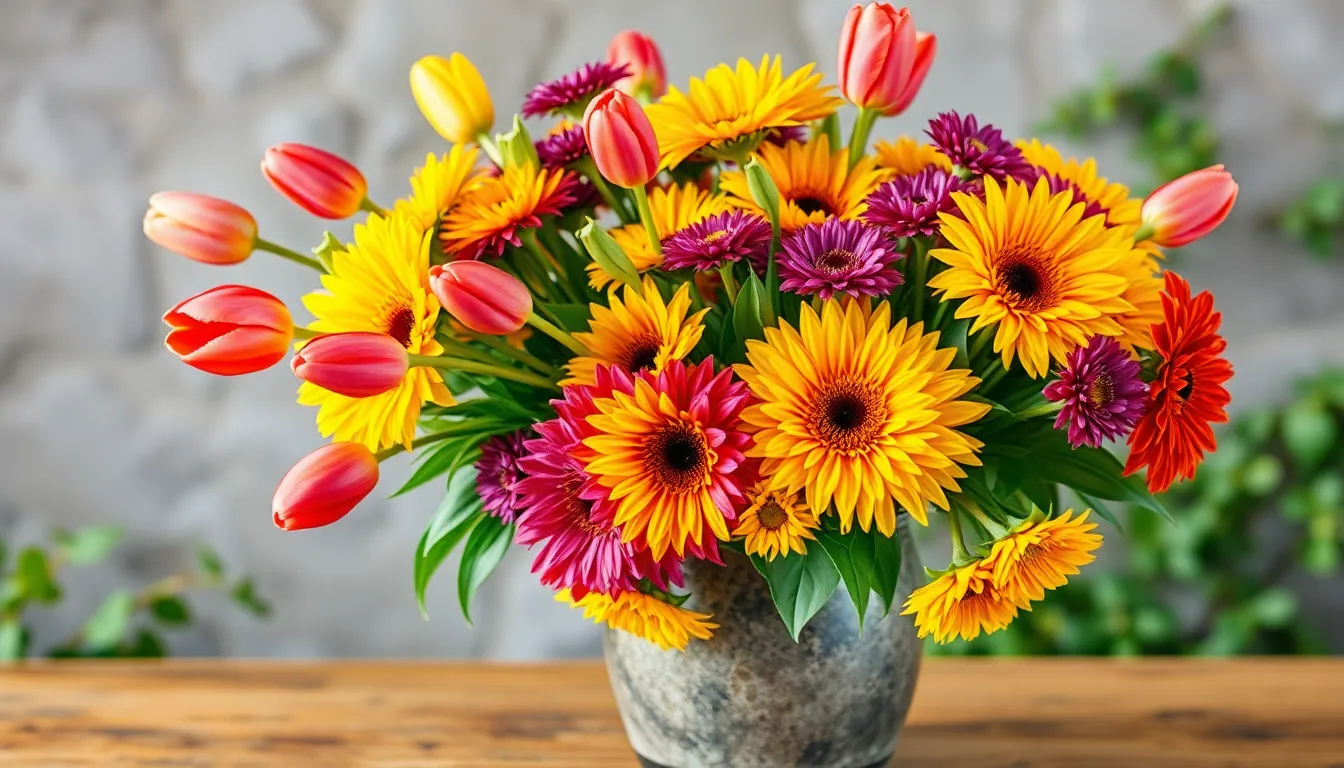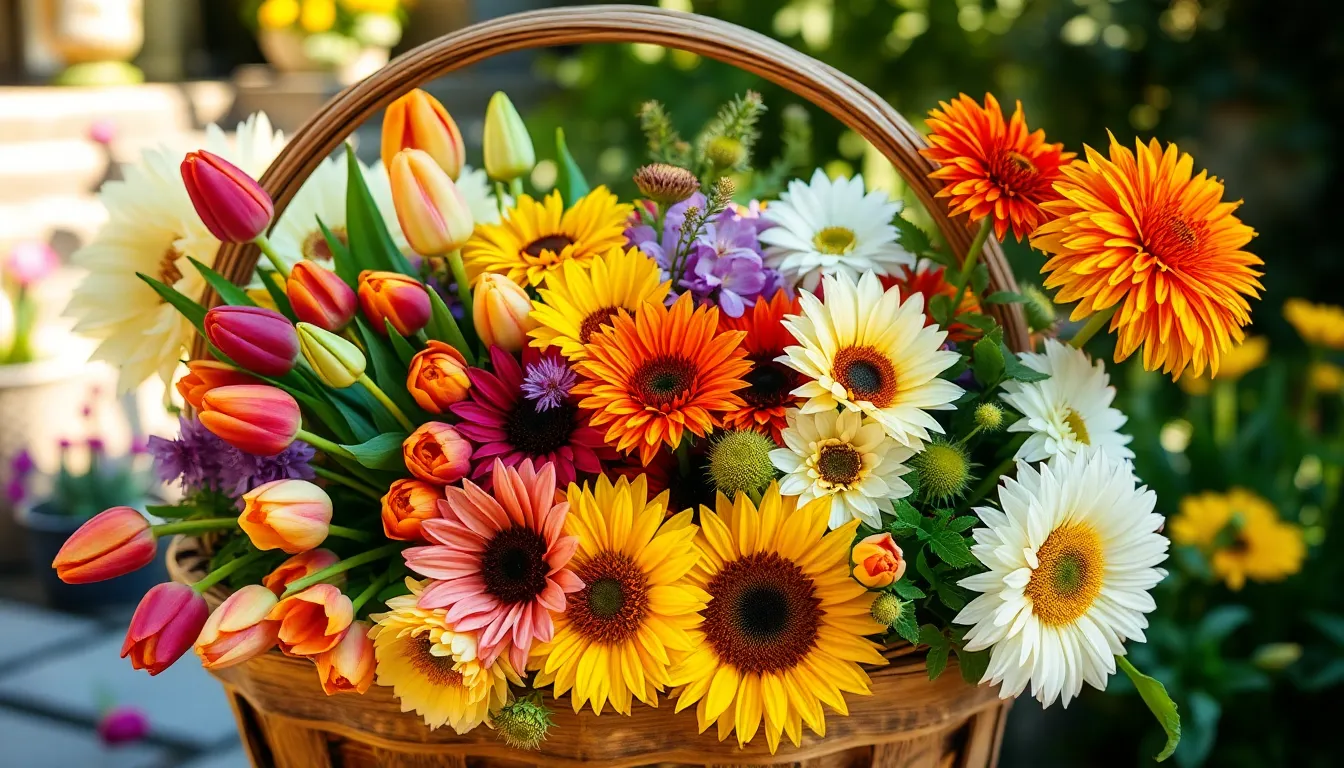Ever walked into a room and felt instantly uplifted by the sight of vibrant flowers? DIY floral arrangements can transform any space from drab to fab without breaking the bank. Who needs a florist when you can channel your inner Martha Stewart? With just a few simple tips and some snazzy blooms, anyone can create stunning arrangements that’ll have friends wondering if you’ve secretly taken a masterclass in flower arranging.
Table of Contents
ToggleUnderstanding DIY Floral Arrangements
DIY floral arrangements offer a chance to customize and beautify spaces affordably. These personal touches create unique creations for any occasion.
Benefits of Creating Your Own Arrangements
Crafting individual floral designs fosters creativity and personalization. Savings on costs arise when selecting flowers and materials. Enjoying a therapeutic experience brings relaxation while arranging blooms. Moreover, these arrangements often create lasting memories during special events. People appreciate the opportunity to choose color schemes and styles that reflect their tastes. Achieving a sense of accomplishment strengthens the motivation to try new designs in the future.
Essential Tools and Materials
Gathering essential tools enhances the arrangement process. Scissors or floral shears provide precise cuts, ensuring optimal flower freshness. A good-quality vase stabilizes stems and showcases beauty. Use floral tape to secure arrangements and create desired shapes. Floral foam supports flowers while retaining moisture, extending their lifespan. Gathering fresh flowers and greenery adds vibrancy and variety. Using wire and clips can provide additional support for delicate stems. Collecting these tools streamlines the crafting process and leads to stunning arrangements.
Choosing the Right Flowers


Selecting suitable flowers plays a crucial role in creating beautiful DIY floral arrangements. Different flower types can significantly influence the overall aesthetic and mood of the arrangement.
Seasonal Flower Selections
Seasonal flowers offer freshness and vibrancy, making them ideal choices. Spring introduces tulips, daffodils, and peonies. Summer showcases sunflowers, dahlias, and zinnias. Autumn brings chrysanthemums, asters, and sedum, while winter features amaryllis, poinsettias, and evergreen varieties. Choosing flowers in season not only ensures optimal freshness but also reduces costs. They thrive in their natural environment during their peak season, providing aesthetic appeal and longevity in arrangements. Always consider local availability to enhance the selection process.
Color Schemes and Combinations
Color plays a vital role in the impact of floral arrangements. Complementary colors create vibrant contrasts that draw attention, while analogous colors provide soothing harmonies. For instance, using reds and oranges evokes warmth, whereas blues and purples induce calmness. Incorporating neutral flowers, like whites and greens, can balance bold hues. Limit the palette to three or four colors for cohesive arrangements. Experimenting with different shades adds depth and visual interest, ensuring the final product captivates and enchants viewers. Prioritize color schemes based on the occasion to enhance the overall message of the arrangement.
Step-by-Step Guide to DIY Floral Arrangements
Creating stunning floral arrangements involves a few essential steps. Readers can follow the process to design beautiful and personalized displays.
Preparing the Flowers
Start by selecting fresh flowers from local sources. Trim stems at an angle to promote better water absorption. Remove any leaves that may sit below the waterline to reduce bacterial growth. Soak floral foam in water if it’s used, ensuring it saturates fully for optimal hydration. Gather all materials in one space for convenience.
Arranging Techniques and Tips
Begin arranging by adding larger flowers first for a foundation. Incorporate filler flowers next to create volume and depth. Position greenery to fill gaps and enhance symmetry. Maintain balance by varying flower heights. Ensure colors flow harmoniously by using a limited palette for visual cohesion. Rotate the arrangement frequently during the process for an all-around view. Adjust elements as necessary to achieve the desired aesthetic.
Creative Ideas for DIY Floral Arrangements
DIY floral arrangements offer countless creative possibilities. From vibrant centerpieces to unique containers, customizing designs enhances any space.
Centerpieces for Different Occasions
Centerpieces serve as the focal point, transforming tablescapes for various events. For weddings, tall arrangements featuring elegant lilies and peonies create a romantic atmosphere. Birthdays benefit from colorful mixes of sunflowers and daisies that capture joy. Seasonal celebrations, like Thanksgiving, shine with arrangements of autumn foliage and chrysanthemums. Choose flowers that reflect the theme while balancing height and stability for eye-catching designs.
Unique Vases and Containers
Unique vases add character, elevating floral displays. Mason jars bring a rustic charm, while vintage teapots convey a sense of nostalgia. Some may prefer geometric glass containers for a modern touch, which creates a striking contrast to organic blooms. Experimenting with unconventional items, like wooden crates or ceramic bowls, enables personalization. Consider colors and textures that harmonize with the floral arrangement for a cohesive look.
Maintenance and Care for Floral Arrangements
Proper maintenance extends the life of floral arrangements and enhances their beauty. Attention to watering, nutrition, and recognizing signs of decline ensure vibrant displays.
Watering and Nutrition
Watering is essential for keeping flowers healthy. Change the water in the vase every two to three days to prevent bacterial growth. Including flower food in the water provides nutrients that prolong freshness. Hearty flowers benefit from regular checks of their water levels. Adjust the amount based on the arrangement’s size and the environment’s temperature. Fresh, clean water is critical for all types of flowers, ensuring they receive adequate hydration.
Signs of Flower Decline
Yellowing leaves often indicate that flowers need attention. Wilting, drooping petals are additional signs that arrangements require a change in care. Flowers losing their vibrancy signal that they might not survive much longer. Inspecting flowers daily helps catch these signs early. Stems can also become slimy, indicating bacterial growth in the water. Disposing of declining flowers not only maintains the arrangement’s beauty but prevents the spread of decay to healthier blooms.
DIY floral arrangements offer a unique blend of creativity and personalization that can elevate any space. By experimenting with seasonal flowers and thoughtful color schemes, anyone can craft stunning displays that reflect their style. The process not only saves money but also provides a fulfilling experience that can be shared with loved ones.
With the right tools and techniques, creating beautiful arrangements becomes an enjoyable endeavor. Regular maintenance ensures that these floral masterpieces remain vibrant and fresh. Embracing the art of DIY floral arrangements can transform ordinary moments into extraordinary memories, making every occasion special.


